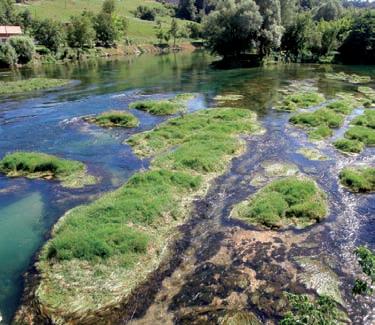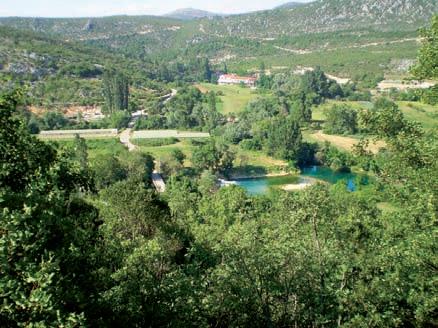
43 minute read
ABOUT THE CONCEPT OF SUSTAINABLE TOURISM
Responsible tourism should:
a) optimally use natural resources that are an important element of tourist development, maintain necessary ecological processes and help preserve natural heritage and biodiversity. b) Respect local socio-cultural identities, preserve their cultural heritage and traditional values and contribute to better cultural understanding and tolerance. c) Ensure visible long-term economic activities, socio-economic bene ts for all stakeholders and their equitable distribution, including the possibilities of employment, pro t generation and welfare services for local communities in order to contribute to poverty reduction.
Advertisement
Development of responsible tourism calls for an active involvement of all important stakeholders and a strong political leadership that can enable participation of a large number of stakeholders and contribute to the decision-making processes by means of consensus. Responsible tourism is a process that takes time and requires constant control of impacts, proposing preventive and corrective measures whenever deemed necessary. It should also re ect a high degree of satisfaction and experience on the part of tourists and raise their awareness of the sustainability issue and promote principles of sustainable tourism.
“Development of tourism should be based on sustainability, which means that in the long run it must be ecologically endurable, economically cost-e ective and ethically and socially acceptable to local communities.”(Chapter on Sustainable tourism, world conference in Lanzarote, 1995). e Organization of Independent Tour Operators has proposed a number of guidelines of sustainable tourism that are similar to the principles identi ed by Martha Honey (Eco tourism and sustainable development. Who owns Paradise? Martha Honey, Washington, D.C., Island Press, 1999.) • protection of environment - ora, fauna and landscape • Respect for local culture – tradition, religion and cultural heritage • Contribution to local communities – in economic and welfare terms • Protection of natural resources – from o ce to destinations • Minimum pollution – noise, waste disposal and over-crowdedness with tourists.




e term “responsible tourism” actually implies an ethically inspired reaction of the civilized world to o en very negative impacts which mass tourism has caused and continues to cause in the areas that are visited by a large number of people. e inception of the term dates back to the 70s of the past century, the time when the mass tourism had aggressively spread all over the world, causing thereby especially harmful consequences for both social and physical tissue of underdeveloped countries. Already in 1987 Brundtland* de ned sustainable development as a development that meets the needs of today, without compromising the possibilities for the future generations to satisfy their needs.
Since the United Nations began to continuously and loudly advocate the need for observance of the sustainability principles, the concept of “sustainable development” has been transformed into the guidelines for an individual’s attitude to the world that surrounds him, not only to the natural environment, but also the cultural and historic heritage. anks to the e orts of numerous organizations, movements, interest groups and individuals, who took it upon themselves to ght for the protection of natural wealth and cultural and historic heritage, the consumer society has slowly started to change. Even before the beginning of the third millennium, mass tourism started to gradually lose its status and give way to di erent types of the so-called “alternative tourism”. e o er always has to adapt to the demand, which was also the case here. anks to the rising numbers of consumers who quite knowingly adopted the term of responsibility towards future generations, new types of tourist o er have emerged, with new and original attractions that in a responsible manner exploit the wealth of the territories in which they are found. It must be noted here that the transformation of consumers and their choice of alternative tourist products was conditioned by the development of the new information technologies, which has not only facilitated the spread of information, but also lead to the development of a new consciousness and new perception of the connection between individual actions and development of “a global village”. To educated and enlightened people, the concept of responsible tourism has become a life philosophy.

Responsible Development of Territories
Of course, the responsibility for the protection of a local area does not rest only with the consumers, but also with local authorities that are in charge of its development. If we want to move on from the concept of “sustainable tourism” to “responsible tourist development,” we must rst establish what de nes the latter. If we comb through the numerous declarations and de nitions that, following lengthy discussions, were adopted by the participants of many international conferences organized in di erent parts of the world (Cape Town, Rio de Janeiro, Manila, Lanzarotte etc.), we will compile a long list of the important determinants of the responsible tourism. However, if we want to sum up the necessary prerequisites, we will easily come to a number of the indispensable and inevitable preconditions: (a) Optimization in the use of environmental resources (b) Protection of environmental processes (c) Protection of natural heritage and local bio-diversity, (d) Protective approach towards local culture, traditional values and socio-cultural peculiarities (e) Feasibility of long-term economic activities
Responsible tourist development must follow the principles of sustainability and, therefore, must be ecologically tolerable/endurable, economically cost-e ective and ethically and socially just. erefore, every development project should protect the environment and preserve the natural resources by reducing pollution to the minimum. A territory in its entirety belongs to the community as a whole. Management of the territory`s resources requires an environmentally aware involvement of all players. Every development project should provide some economic bene ts for all local stakeholders.

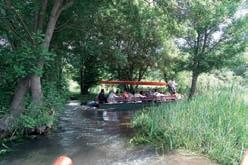

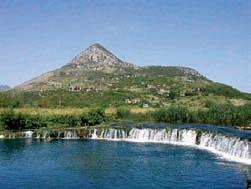
RESPONSIBLE TOURISM IN BIH
Already in medieval times, , as the inhabitants of the country which lied on the crossroads of trade routes and abounded in beautiful scenery, rich natural assets and delicious food, Bosnians and Herzegovians were reputed as “good people”.
In addition to the proverbial hospitality of its people, its incredible natural wealth and springs of potable water, its geographic position is another reason why Bosnia and Herzegovina has been dubbed “the heart of the Balkans.”
According to the projections by the World Tourist Organization (UNWTO), Bosnia and Herzegovina will take the third place on the global scale in terms of its tourist market growth which has been estimated to reach 10.5% in the period from 2015to 2020.
In the 18th century, rural tourism was reserved for the privileged classes, that is, the aristocracy and bourgeoisie, and mostly in England. Today, it attracts more and more tourists from all social classes because of the unique experience it o ers and the contribution in the protection of natural heritage and local communities.
Since there is no universally acceptable de nition of rural or country tourism, we will try to provide answers to most frequently asked questions about this particular kind of tourism in the next chapter.



RULES OF RESPONSIBLE TOURISM
Responsible tourism implies compliance with a number of rules and obligations by both the visitors and hosts, that is, the community that has organized the trip and entertains guests.
Simply put, responsible tourism is a direct opposite of the mass tourism where a tourist rarely comes in direct contact with the inhabitants of the place he visits and his trip rarely contributes to his personal and cultural enrichment. In contrast to responsible tourism, the mass tourism encourages development of large corporations and hotel chains that not only don’t contribute to the development of local economy, but o en endanger local eco-systems.
WHY RESPONSIBLE TOURISM IN THE FIRST PLACE
Responsible tourism is a direct opposite of the mass tourism. It primarily implies the responsibility towards natural environment and commitment to its preservation, which is the basic precondition for a long-term sustainable development, or in other words, for the well-being and life quality of the local population. Responsible tourism is a project that can only function with an active participation of local population. In that sense, the rst task in the promotion of responsible tourism is education that seeks to raise the awareness of the local community on all levels, from small children and teenagers to the mature adults who are still socially and economically active. e awareness of the responsible tourism does not only relate to the providers of tourist services, but also to their users. In developed countries, the awareness and commitment to responsible tourism is recognized as a sign of civility, the knowledge that commits an individual to protect and preserve the environment and to respect local culture, customs and beliefs.
Sustainable development and social entrepreneurship are the synonyms for the charted development of the modern society which values equality, justice, generosity and moral virtues that are slowly disappearing from the globalization processes of today. e fast uncontrollable progress, powerful construction lobbies, overly constructed coastline, mass tourism, all of this brings huge pro ts, but the question is - who actually pro ts from it? And is such development sustainable at all?
PRODUCTS OF RESPONSIBLE TOURISM
ese are products that function in harmony with the local environment, culture and community in the way that the latter all become bene ciaries and not victims of tourist development.
In many countries in which tourism makes an important share in annual revenues, it is very important to preserve the traits that make their product one of a kind. e principles of sustainable and responsible tourism have been applied ever since the quality of the environment and local community were recognized as part of the economic aspect. Availability of these components is the basis for the viability and survival of economic activities. e principles of improvement of sustainable tourism can help local authorities to organize their activities in a comprehensive way. ere are more and more tourists who opt for responsible tourism and therefore, successful application of principles of sustainable tourism represents good practice in the promotion of any country.


Characteristics of responsible tourism
Responsible tourism is: • Informative; not only can visitors learn something about their destination, but they can also learn how they can help it to preserve its attractions and at the same time deepen their experience of the trip. On the other hand, hosts can learn how the ordinary and everyday can become much more interesting and valuable to visitors. • It supports the integrity of the area: visitors insist on skills and cra s that underscore the unique characteristics of the destination such as indigenous architecture, cuisine, cultural heritage, esthetics and ecology. us, revenues generated through tourism increase in the eyes of the local population the value of the local assets. • It brings bene ts to local population; travel agencies do their best to train and employ local inhabitants, purchase local products and use local services. • Protects resources; environmentally aware travellers prefer businesses that have no adverse impact on the environment. • It respects local culture and tradition; foreign guests visit local destinations, learn about local peculiarities and learn several polite expressions in local language. Local population learns how to ful ll the expectations of foreigners that may be di erent from their own. • It does abuse its own products; stakeholders predict excessive development, set limits and adopt useful management techniques for its prevention. Businesses work together to protect natural habitats, cultural and historic attractions and local culture. • It aspires towards quality, not quantity; local communities measure the successfulness of tourism not by the number of guests, but by the length of stays, the amount of money spent and the quality of experience. • It stands for a wonderful journey; satis ed visitors take home new insights about the place and advise their friends to visit the same destination, which provides a steady in ow of visitors to the destination.


In order to o set the damage caused by mass tourism, local and state authorities have dra ed documents and chapters and adopted initiatives to legalize the principles of sustainable development that were rati ed at the rst conference of the United Nations in Rio de Janeiro in 1992. Some more important global documents that speak about the concept of sustainable tourism are the following: - Declaration on world tourism adopted in Manila, 1980. - e Brundtland Commission used in the report “Our joint/common future” from 1987. - Agenda 21 on travel and tourism adopted by the World Council on Travel and Tourism, the
World Tourist Organizations and the Council of countries in 1991. - World Summit - UNEP, Rio de Janeiro, 1992. - Agreement on Sustainable Tourism, 1995, (together with the UNEP, UNESCO, EU) - Berlin Declaration, 1997. - Global code of ethics-conduct in tourism, the World Tourist Organization, 1999. - Carta di Rimini on Sustainable tourism, 2001. - Mohonk Agreement: proposal on the international certi cation program for Sustainable tourism and eco-tourism, 2000. - World Summit on sustainable development, Johannesburg, 2002.
European environmental policies are contributing to the development of responsible tourism with their directives, instruments of volunteerism and fundamental prerequisites as follows: - SEA, Strategic environmental assessment; the directive foresees that environmental impact assessments be prepared for regional and local plans and projects during their elaboration and prior to their adoption. - VISIT, volunteer initiative for sustainability in tourism, LIFE 2001 / 2004; the initiative is the rst
European travel guide that rates environmental quality of tourist destinations and is designed to demonstrate that European eco brands can work together to push the tourist market towards sustainability. - European Charter on tourism in protected areas; it treats global and European priorities outlined in the recommendations of Agenda 21 adopted at the world summit in Rio in 1992 and by the
EU sixth program for environmental protection and the strategy for sustainable development.

Agreement on Sustainable Tourism, Lanzarote 1995
e world conference on sustainable tourism held in Lanzarote (the Canary Islands, Spain, 1995) adopted a chapter on sustainable tourism. is chapter approaches tourism using global methodology and urges the international community and all world governments, all decision makers from the eld of tourism, as well as public and private enterprises whose activities are connected with tourism to adopt 18 principles that make tourism responsible and sustainable. 1. Tourist development should be based on sustainability, which means that it must be long-term environmentally tolerable, economically cost-e ective and ethically and socially acceptable to local communities. Sustainable development is a process that implies global use of resources to ensure their cost-e ectiveness and thus enable our natural and cultural capital, protected areas included, to be preserved as a powerful instrument for tourist development that can and should be actively used in the strategy of sustainable development. 2. Tourism should contribute to sustainable development and be integrated into our natural, cultural and social environment; it must respect the sensitive balance that characterizes many tourist destinations, especially small islands and environmentally vulnerable areas. Tourism should ensure acceptable development in terms of its impact on a destination`s natural resources, biodiversity and capacities. 3. Tourism must take into account its impact on cultural heritage and traditional elements, activities and dynamics of every local community individually. An important role in formulating the strategy of tourism, in particular in the developing countries, must be given to the recognition of local factors and support for the identity, culture and interests of a local community. 4. Active contribution of tourism to sustainable development requires solidarity, mutual respect and participation of all stakeholders, both public and private ones involved in the process, and it must be based on e cient mechanisms for cooperation on all levels: local, national, regional and international. 5. Conservation, protection and respect of natural and cultural heritage can be helpful in establishing cooperation. is approach implies that all responsible stakeholders must accept the challenge of cultural, technological and professional innovations and make additional e orts to create and implement instruments for integrated planning and management. 6. Set quality standards both in the protection of destination and the capacities that will satisfy tourists` needs. ese criteria must be adopted in cooperation with the local community and in accordance with the principles of sustainable development. 7. In order to become a part of sustainable development, tourism must be based on a variety of opportunities that a local economy o ers. It must be fully integrated and positively contribute to the development of local economy. 8. Tourism developmental options should contribute to the improvement of the quality of living of all people and e ect socio-cultural enrichment of every individual destination. 9. Governments and local authorities, in cooperation with non-governmental organizations and local communities, should aspire towards integration and planning of tourism through sustainable development. 10. Given the economic and social cohesion of people in today`s world, as the fundamental principle of sustainable development it is important that the measures advocated enable an equitable distribution of the bene ts and burdens of tourism. is relates to changes in the consumption pattern and introduction of the evaluation methods that would enable internationalization of the costs of environmental protection. Governments and international organizations should give priority to and strengthen direct and indirect aid for the projects in tourism that contribute to environmental quality.
11. A priority should be given to areas that are sensitive in environmental and cultural terms both now and in the future by administering nancial and technical assistance for development of sustainable tourism. 12. Promotion of the alternative forms of tourism that are in line with the principles of Sustainable development, together with enhancing and encouraging diversity, represents both a short- and long-term guarantee of stability. 13. Governments, industries, authorities and non-governmental organizations should promote and participate in building open networks for survey, spread of information and transfer of knowledge about tourism and techniques of sustainable tourism. 14. e policy of sustainable tourism requires support and promotion of the environmentally compatible systems of tourist management, feasibility studies for transformation of the sector, implementation of pilot projects and development of international cooperation programs. 15. Travel agencies, in conjunction with organizations whose activities are linked with tourism, should establish special frameworks for positive and preventive actions that should ensure development of sustainable tourism and set up programs to support implementation of such practices. ey should also monitor accomplishments, report on results and exchange experiences. 16. A special attention should be paid to the role of tourism in environmental impacts in connection with transportation means and to development of economic instruments that contribute to reduced use of non-renewable energy sources and at the same time encourage recycling and reduced impacts on protected areas. 17. Adopting and exercising the code of conduct in accordance with the principle of sustainability on the part of key players in tourism, especially tourist industries. It is crucial that tourism be sustainable. Such code of conduct can be an e cient instrument in the development of responsible tourism.
18. All necessary measures must be introduced in order to inform and raise the awareness of all those involved in the tourist industry on local, national, regional and international level concerning goals adopted at the conference in Lanzarote.



e Agreement in Mohonk: e proposal for international certi cation programs in sustainable tourism and eco-tourism
e Agreement in Mohonk outlines a set of general principles and elements that should become incorporated in every certi cation program for eco-tourism and sustainable tourism. e framework was unanimously adopted in the joint conclusions of an international workshop organized by the Policy Research Institute with the support of the Ford Foundation. e workshop was held in a mountain cabin in Mohonk, New Paltz, in New York from 17 to 19 November 2006.
Participants of the workshop concluded that certi cation programs in tourism must be additionally modi ed to adapt to speci c geographic regions in today’s tourist industry. ey also agreed that certi cation program should be followed by general components which every certi cation program for eco-tourism and sustainable tourism should t into.
General Certi cation Framework
Basic Scheme
All stakeholders and sectors should be involved in the development of certi cation programs (including representatives of local communities, tourist agencies, non-governmental organizations, government, etc.) • Such scheme should provide bene ts for service providers and o er tourists the possibility of a choice. • Provide bene ts to local communities and facilitate their preservation. • Set up minimum standards and at the same time encourage and reward examples of good practice. • Allow for the possibility of certi cation withdrawal in case of non-compliance. • Establish control of the existing certi cates in terms of their proper application, expiry of the validity date or annulment of the document/certi cate. • It should introduce commission-fees for technical assistance. • It should be designed in the way that allows for constant improvements of the certi cate itself and the products/companies that are being certi ed.
Criteria
• ey should provide mechanisms that lead towards accomplishment of charted goals. • ey should lead to a better quality of services and if possible towards regular upgrading of service quality. • ey should include global examples of good practice of touristic management in environmental, social and economic terms. • ey should be adjusted to recognize local/regional environmental, social and economic conditions, as well as initiatives of the local community for sustainable development. • Criteria should be periodically reviewed. • Essentially, they should be based on performance and include elements of environmental, economic and social management.
Integrity
• Certi cation program should be transparent and envisage the possibility of an appeal. • e body in charge of certi cate issuance should be independent in its work and free from any in uences by interested parties, technical assistance or bodies in charge of evaluation of the certi cate itself (technical assistance, administrative structures, con ict of interest should be avoided in the evaluation and review process). • Reviews should be conducted by authorized revisers. • It should contain mechanisms that allow for the possibility of an information feedback for consumers and local community.







Criteria of sustainable tourism
Sustainable tourism aspires to minimalize environmental and socio-cultural impacts, while at the same time providing economic pro t for the local community, i.e. the host country.
Criteria that are applied in de ning Sustainable tourism in any certi cation scheme should meet the minimum standards in view of the following aspects:
General
• Social, cultural, ecological and economic impacts are taken into account in the preparation of environmental impact studies and adoption of regional plans. • Obligations of tourist business entities in the responsible environmental management. • Professional training of expert sta , education, responsibility, knowledge and raising the awareness about environmental management and cultural changes and speci cs.


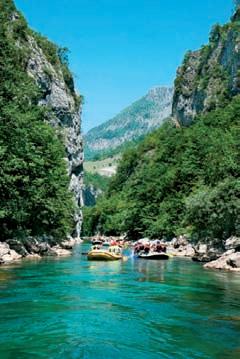


• Setting up mechanisms for reporting and control • Responsible marketing based on realistic expectations • Setting up mechanisms for information feedback from social/cultural consumers • In uence on social structures, culture and economy (local and national level). • Appropriate procedures for access to and mediation in land sale/purchase • Measures that ensure social cohesion of a community • Mechanisms that enable recognition of the environmental rights and aspirations of the local and/or indigenous population • Suitability of location • Protection of eco system’s biodiversity and integrity • Impact on the location itself, landscape and the possibilities of rehabilitation • Management of drainage canals (precipitation waters) • Sustainability and minimal use of energy sources • Sustainability and minimal use of water supply system • Sustainable management of waste waters • Air quality and noise reduction (including greenhouse gases) • Waste reduction and the sustainability of waste disposal • Landscape/visual impacts • Sustainability of raw materials and supplies (materials recycled or produced on the location, certi ed products etc.) • Minimum environmental impact of tourist activities
Economic
• e need for introduction of ethics into business dealings • Mechanisms that ensure that the employment contracts and procedures are not exploitative, but in compliance with local laws and international labor standards (depending on which standards are higher). • Mechanisms that ensure a minimum negative economic impacts on local community, but instead bring considerable economic bene ts to local community. A positive economic impact of tourism is o en described as something that brings bene ts to the tourist destination itself, while negative environmental and social impacts are perceived as expenditures. In reality, economic, environmental and social impacts can at the same time be both positive and negative and the challenge in developing sustainable tourism lies precisely in ensuring pro ts in all areas.
Economic in uence
A tourist development of a country or a region is o en considered as an opportunity for poverty reduction through employment and pro t generation. On the other hand, if tourism is not developed and managed in a responsible way, by taking into account local needs, the real long-term economic bene ts can be smaller than expected. e basic reason why local population fails to draw bene ts from tourism is when goods and services used in tourism are produced and purchased outside of the country or region. Also, government investments into tourist infrastructure, such as roads, airports or hospitals, can mean that fewer funds are made available for the basic needs of the local population. Other possible expenditures include the repair of air and water pollution caused by tourist activities, losses caused by the ailments in icted through pollution and increased living costs of the local population caused by the elite tourism.
However, tour-operators can contribute to increased economic sustainability of tourism at a destination by creating a tourist o er in the way that ensures maximal local, regional and national economic pro t.
Generally speaking, positive economic impacts can be reduced down to three categories: direct, indirect and impelled.
Direct pro ts include tourist spending on food, souvenirs, excursions, tips etc. at the destination itself. It also includes money paid by tour operators to local suppliers, including hotels and local transportation companies. Of course, if a hotel is owned by foreigners, direct bene ts will be lower given the fact that a portion of money earned will leave the country. Direct local pro ts can be increased by creating tourist packages that rely on local suppliers alone.
Indirect bene ts include pro ts and jobs created through the services provided to tourists. For example, if hotels purchase food locally they can create jobs and pro t to local farmers and factories. Indirect bene ts can be increased through bigger consummation of local products, in which case a destination will need fewer tourists to generate the same economic pro t.
Finally, impelled pro ts arise from the bigger purchasing power of employees and their families as a result of higher employment in tourism. e opportunity for generation of this sort of pro ts is higher in large areas with a more diverse economy. On a small island where tourism is the main industry, employees have fewer possibilities for spending their salaries on locally produced goods. Economic bene ts can sometimes be stimulated in a place that is far away from the tourist destination itself. For instance, cruiser employees o en send their pay checks back to their home countries.
Environmental Impact
Tourism can have a wide range of negative environmental impacts that are sometimes irreparable and irreversible. In most extreme cases, a long-term environmental degradation has destroyed the landscape that has been drawing the tourists to a destination to the point that leading tour-operators and their customers are beginning to avoid such places and opt for new and better preserved destinations instead. e impact of tourism on environment is determined by the design-plans and construction of the tourist facilities like airports, hotels, roads etc., their daily functioning and the behavior of tourists. e biggest potential for causing long-term damage and negative impact lurks in the initial stage of a design plan or construction, but it also o ers the possibility of ensuring a development of sustainable tourism. At this initial stage, the government decides what type or level of tourist activity will be developed at a certain location through adoption of the urban plans and issuance of building permits for tour-
ist facilities in the area. If ill-planned, the construction site and facility itself can degrade the landscape and lead to a loss of biodiversity as a result of the destruction of natural wildlife habitats, that is, the coastline, woods, coral reefs and other eco-systems. e design plan of a tourist facility itself can be bene cial to its long-term impact, which depends on a number of factors from the quantity of water and energy required for the operation of the facility, the quantity of waste that will be produced to the manner in which waste disposal will be managed. If the principles of adequate design-planning are applied the aforesaid long-terms impacts can be signi cantly reduced. In addition to its direct impact on a local destination, tourism can also have a global impact as a result of carbon-dioxide emissions by planes and other means of transportation that a ect climate change.
Although tourism can create unwanted expenditures for its immediate surroundings, it can also become a source of bene ts. For example, the income from tourism can be used in funding the local protected nature sites so that their economic importance for the country or region may become bigger. Tourism can help protect forests and coral reefs by promoting their recreational purposes instead of consumer economic activities such as shing or wood logging. Tour operators can have in uence on the adoption of laws that seek to protect the natural attractions, as well as the behavior of tourists at these nature sites. An increased tourist interest in a location can bring about environmental bene ts in the form of an increased awareness of the local population about environmental issues, which should help them to understand the real economic value of the place provided its natural wealth is preserved.




• Socio-cultural impact
Negative socio-cultural component of tourist development
A negative socio-cultural impact of tourist development on a local community is not always immediately visible. First, the presence of tourists who have di erent cultural habits and traditions and their bigger purchasing power can lead to con icts or emotional discomfort. Inappropriate display of personal wealth, photographing local people without asking them for their permission or wearing provocative clothes, especially in strict religious areas, are all examples of the behavior that can be seen by locals as o ensive (locals might behave politely and not show it outwardly). Although sustainability can generate some instantaneous economic advantages in terms of the reduction of expenses and improved relations with employees and the local community, many bene ts, both to individual companies and the society as a whole, are long-term.
Furthermore, not all bene ts are tangible since some of them cannot be measured, consequently, investing into sustainability is sometimes di cult to justify.
Bene ts of behaving responsibly
Key business bene ts of tour operators who behave responsibly include: • Bigger pro ts. If it becomes clear that tour operators conduct their business by the principles of sustainability, their pro ts will grow bigger because they will secure the loyalty of their clients and attract news ones, which will result in a bigger market for the tour operators. • Savings. Operating by sustainability principles can help lower operational costs and improve overall productivity and e ciency due to reduced use of resources, reduced waste production and avoidance of unnecessary nes. • Access to capital. Given the fact that environmental and social criteria are becoming a standard in any risk assessment, tour operators who do business by sustainability principles have better chances of attracting capital from banks and investors. • Human resources. ere are bigger chances that employees will feel proud about working for employers who take their responsibility towards society seriously. Tour operators who are known for their sustainability policy have a better capacity of attracting and retaining trained and talented sta , which in turn increases their prospects of innovation and market competitiveness. • Brand value and reputation. e reputation about a tour operator`s sustainable business adds values to its brand and strengthens its standing on the market, whereby the brand becomes less susceptible to short-term economic and market changes. • Protection of destination. By operating in a sustainable manner, a tour operator can help make a tourist destination a pleasant place to visit and live in. By securing the long-term quality of a destination, a tour operator can secure his own business lucrativeness. • Improved service. Sustainable management of a tourist facility makes it more safe and healthy for both employees and guests and at the same time supports the local community and its economic bene ts, as well as the morale of employees. e nal outcome is an improved service and bigger satisfaction of guests. • Risk management and work license. Tour operators can reduce their liability by learning about legislation that is possibly “harmful” to their business. For example, the risk of loss in icted through a damage caused to a company`s business reputation can be reduced by demonstrating a proactive approach about a destination`s sustainability and product quality, which can be e ectively used as a defense/counter-argument in any lawsuit.
From Principles to Practice: Examples of Good Practice
A global care for the development of sustainable tourism has already generated examples of good practice.
• Environmental program of the Central America- PROARCA/APM
Protected areas and ecological components of the program for the Central America or PROARCA/ APM is a three-year program that commenced in 2001 with the goal to consolidate the Central America’s biological corridor through improved management of the protected nature parks in the region and by expanding the production of and market access for ecologically acceptable products and services. e Central American Commission for Environment and Development, whose members are ministers of environment of Guatemala, Belize, El Salvador, Honduras, Nicaragua, Costa Rica and Panama, was in charge of running the program with the nancial support of the US Agency for International Development (USAID). e initiative was implemented by Nature Conservancy, World Wildlife Fund (WWF) and Rainforest Alliance.
• Local Agenda 21, Calvia
e municipality of Calvia on Mallorca, Spain, was su ering from environmental and developmental degradation as a consequence of the large-scale investments into mass tourism during the 70s and the 80s of the past century. Radical changes were required for the recovery of the local community.
• Tourism of Tomorrow Award
is award program recognizes and encourages Sustainable tourism. e Award of Tomorrow is presented to the selected projects and examples of good practice, setting higher standards and challenging others to meet them. e award was originally established by the Tour Operator Federation in order to encourage all entities and sectors in the tourist industry to environmental protection. In 1992, the British national air carrier took over the sponsorship, whereby it successfully incorporated all aspects of sustainable tourism. Small and large-scale tour operators, small hotels, as well as international hotel chains, national parks and areas with well-preserved cultural heritage are only some of the candidates eligible for awards from this award program. Link to web-site: www. britishairways-com/tourism.



Why Guidelines of Responsible Tourism?
An increasingly more important strategy encouraging a sustainable production of goods and services was introduced through certi cation programs. e World Summit in 1992 focused global attention towards e orts that sought to make the development more responsible. e emerging market regimes restrained the power of governments to set up environmental and social standards in business. e certi cation initiatives originated from the non-governmental market-oriented initiatives for promotion of sustainability by encouraging consumption of goods and services produced by companies that met high social and economic standards of production.
Following the world summit, certi cation programs were established to de ne and measure the sustainability of various industries. e main certi cation programs in tourist industry are: - Green Planet 2 l (Global certi cate) - Blue Flag (Global certi cate) - Green business in tourism (Scottish certi cate) - Program of accreditation of nature and eco-tourism (Australian certi cate) - Certi cate on sustainable tourism (Costa Rica) - America sustainable tourism certi cation network in Brazil - October 23, 2003 e Berlin Declaration on biodiversity and sustainable tourism adopted in 1997 recognized that a more sustainable form of tourism brings bene ts to also the local communities, underscoring thereby the goals of the Agreement from Lanzarote. It also notes that all stakeholders in tourism should cooperate on local, national and international level in order to agree on a common understanding of the term “sustainable truism”.
Recognizing the aforesaid priorities, the Region of Marche, in an attempt to contribute to the development of responsible tourism, adopted the Guideline of Responsible Tourism. e guidelines resulted from the project “Local Centers of Development and Integrated Management of the Coastline” which was promoted by the Region of Marche in cooperation with Sviluppo Marche, a regional development agency and co-funded by the Italian Ministry of Foreign A airs based on the national law on 21 March 2001. e project involves partners, the coastal counties in Croatia and Bosnia and Herzegovina, more precisely, the Zadar County in Croatia and the Mostar Canton in BiH. e goal of the project is to support sustainable development of local communities through the local development centers that work in partnership, exchanging experiences and good practices, in order to achieve an integrated management of the coastline.
In order to identify the joint lines of management, it was necessary to produce speci c studies of the areas covered by the project. For each of the areas involved, the project team dra ed: • e in-depth analysis of tourist potentials (accommodation, infrastructure, transportation, human resources etc.) • e environmental analysis (natural speci cs, geographic characteristics etc.) • e analysis of natural and cultural resources • SWOT analysis that identi es the strengths and weaknesses, potentials and threats e guidelines, which originated from the project for local development centers, should be used as useful analysis tools and for initiating a panel discussion about the establishment of certi cation pro-
grams for the products of eco-tourism. In order to achieve this goal and create tools that can be applied to all types of tourist activities, it is critical that participation of all local players is secured.
A joint program of certi cation can be a valuable and helpful tool to local tourist enterprises in aligning their products with the principles of responsible tourism adopted by the international community. At the same time, it can be an important instrument in the protection of environment and cultural heritage of local communities.
Principles of Responsible Tourism e international community, through studies and examples of good practice, has identi ed indicators of all three aspects of the development of sustainable tourism –environmental, economic and social. e table below shows the indicators, i.e. criteria, for the three aspects:
ree aspects Criteria
ECONOMIC SUSTAINABILITY 1. Action planning and business management 2. Business ethics 3. Responsible marketing 4. Consumer satisfaction
ENVIRONMENTAL SUSTAINABILITY
SOCIAL SUSTAINABILITY 5. Focus on nature sites 6. Environmental management 7. Interpretation and education 8. Contribution to environmental protection
9. Work with local communities 10. Respect and sensibility for local culture


ECONOMIC SUSTAINABILITY
1. Action planning and business management
Good business management and action planning are the foundations of economic sustainability, which in combination with environmental and social sustainability allows for an approach that follows the aforesaid three aspects.
2. Business ethics
Ethical approach applies in business dealings.
3. Responsible marketing
e kind of marketing that is correct and leads towards realistic expectations. e eco-tourism marketing o ers consumers truthful and responsible information about what should be expected from a product and how to respect the natural and cultural peculiarities of the destination.
4. Consumer satisfaction
Eco-tourism constantly keeps up with consumer expectations. Consumer satisfaction is achieved when the actual experience exceeds the realistic expectations of consumers. erefore, eco-tourism activities closely follow and act upon consumer feedback information.


ENVIRONMENTAL SUSTAINABILITY
5. Focus on nature sites
Eco tourism focuses on direct and personal experience of nature. It originates from and relies on the use of natural environs. Its focus is on its biological, physical and cultural characteristics.
6. Environmental management
Eco-tourism is an example of good practice of an environmentally sustainable tourism. e natural environment must not be impoverished through eco-tourism activities, but rather improved and managed in the way that the natural and cultural environment is preserved and enhanced through application of environmentally sustainable practices.
7. Interpretation and education
Eco-tourism o ers the possibility to experience nature in the way that leads to its better understanding, respect and enjoyment. e products of eco-tourism attract consumers who seek stronger interaction with the natural environs and who in di erent ways want to enhance their knowledge, awareness, respect for and enjoyment in nature.
Eco-tour operators provide for a valuable level of interpretation of natural and cultural heritage of the site though employment of quali ed personnel and supply of correct information prior and during visit.
8. Contribution to Environmental Protection
Eco-tourism has a positive contribution in the conservation of nature sites. It involves an active participation in the protection of nature sites visited. In particular, products of eco-tourism are providing constructive contributions to the management and conservation of nature sites. ese contributions may include procurement of materials, nancial or in-kind aid.


SOCIAL SUSTAINABILITY
9. Work with local communities
In a certain way, eco-tourism represents an impetus to local community. In many cases, a local community is an integral part of eco-tourist product. Bene ts of eco-tourism should spill over to include the local community, as well. at, for example, can be achieved through employment of local tourist guides, use of local services and facilities.
10. Respect and sensibility for local culture
Eco-tourism is sensitive about the value of implementation and it includes di erent cultures. It is especially sensitive about indigenous culture. Although the focus of eco-tourism primarily lies on the natural attractions of a region, many of these regions also have a signi cant cultural value, especially the indigenous one. erefore, eco-tourism should also include cultural sites of the destination.



Tourists and their responsibility
Travel and tourism should be planned and achieved as the means of individual and collective ful llment. When this is done with an open mind, travel and tourism become an irreplaceable factor of self-education, development of tolerance and learning about di erences among people, cultures and their diversity. We all play a role in the creation of responsible tourism and travel. e government, business companies and local community must do their best, but as a guest, a tourist can in many ways support and thus give his contribution to their e orts. e World Tourist Organization has adopted a global code of ethics in tourism. It includes a wide range of principles whose purpose is to guide stakeholders along the path of tourist development: national and local authorities, local communities, tourist industry and their professionals, but also visitors, both domestic and international ones. e ethics code was adopted in the resolution of the UNWTO General Assembly at its meeting in Istanbul in 1997. In the next two years, a special committee was set up to dra the global ethics code. e dra document was jointly prepared by the Secretary General and advisor on the UNWTO a airs in consultation with the UNWTO Business Council, the UNWTO Regional Commission and the UNWTO Executive Council.






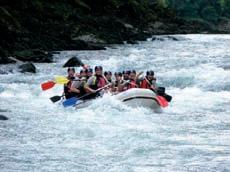






Ten golden rules for sustainable tourists
1. Ask for the kind of an accommodation that is committed to reduction of environmental impacts.
2. Opt for the trip organizer is aware of the impacts of tourism
3. In order to reach your tourist destination, focus on the transportation means that cause less pollution
4. When on vacation, use communal, as well as ecological means of transportation like bicycle
5. Produce less waste and contribute to its di erentiated collection
6. Reduce water consumption
7. Reduce energy consumption
8. Give preference to locally manufactured artifacts and local gastronomic specialties
9. Do your best to respect the environment of the place of your visit
10. Give suggestions and proposals about the possible environmental improvements at the
Source: ICLEI – Local Governments for Sustaina ity www.iclei.org/evrope/tourism
RESPONSIBLE TOURISM IN RURAL AREAS OF BOSNIA AND HERZEGOVINA
In rural environments, family businesses or small businesses, following the concept of their own lifestyle, driven rural tourism. In Bosnia and Herzegovina, which abounds in these areas, this is a great way of evaluation of new and less developed areas. is concept can and should start from the bottom of the pyramid - the desire of entrepreneurs to start up an additional activity that is used for making pro t. However, the concept can be implemented through public-private partnership in which the established rules, regulations, professional sta and nancial system.
Tourist destination policy, which includes the concept of responsible tourism, make and implement government bodies. e authorities also adopted rules and regulations, provide incentives and encourage the private sector, and ensure the political climate that can attract investors. e private sector is developing professional sta ng structure, set up following the foundation is developing a competitive advantage (high quality supply and services), including the development policy through the destination management in the area to create supply. e entrepreneur uses his own farm and a home for pro t (additional commercial activity). Rural tourism is therefore a process of exploitation of favorable circumstances (personal environment) with the aim of gaining additional income (or alternative earnings in the period of agricultural crisis). Within local communities, rural tourism can contribute to the preservation of the village (Economic revitalization and reduce movement of the rural population, especially young people to urban areas).
e entrepreneur needs to pay attention to:
- is aspect of the business shapes the lifestyle of the host, and vice versa. e life style of the host affects the business enterprise. - e concept of quality has not been de ned by lifestyle host, but the demands of tourists. erefore, to achieve successful entrepreneur (ekonoski pro table business), should follow the standards, rules of conduct in tourism, and even surpass the expectations of tourists (more to o er than the tourist demands) in order to increase consumption, trade and sustained loyalty. Happy customers are good guest because the guest made a free and e ective product promotion (promotion by word of mouth). - Relationship to the tourists in the farm should be a combination of host (introduction to the customs of local communities, authenticity, while on the other hand, o ers a host out of the insulation) and professional relationships (some degree of formality). - O er authentic gastronomic o er to prepare the traditional way using its own (organic) products with good access, excellent hygienic conditions and a certain degree of exibility to accommodate the needs and desires of tourists (vegetarian food, food for children). - Farm must not reduce the need for tourists "intimacy" - Rural tourism includes the de nition, creation and distribution of tourism products. erefore, the entrepreneur needs to know the concept of the tourist product (tourist product is a combination of
supply and services, with clearly de ned content and prices that result from experience), creating the same distribution (follow-up marketing, product placement by way of classic and newer forms of emarketing). Within this segment, special attention should be given their own education. - Inventiveness in creating your own deals: allow tourists participate in everyday life- growing organic food, a tour of local historical monuments, sightseeing and hiking with a guide, visits to local events through which they learn about traditional customs). - e adoption of high standards and reducing the elements that threaten the authenticity of - Small businesses o en act spontaneously as a limiting factor. - Entrepreneurs are a key element of the multiplier e ect of economic development in the local community, and as part of the local community, should be stapled / cooperate, because the local population is part of the tourism product (experience, products, services). - O er may involve "complex" forms of services: demand for luxury services, a request for "adrenaline" facilities, di erent levels of fantasy.
A special form of rural tourism, which o ers a specialized program for congressional visitors: - High quality and genuine accommodation in private households - Recognizable and irresistible cuisine -di erent environment - Natural Heritage - Getting to know locals and their customs and habits with regard to posjetetilji spend more time with the locals, but when placed at - High Technology in nearby Congress Centre (conference equipment, ICT, etc).
Staying healthy in the real environment
Motives for visiting the rural farm
The hospitality of the rural population
Relaxation + "healthy" activities: hiking, shing ...



